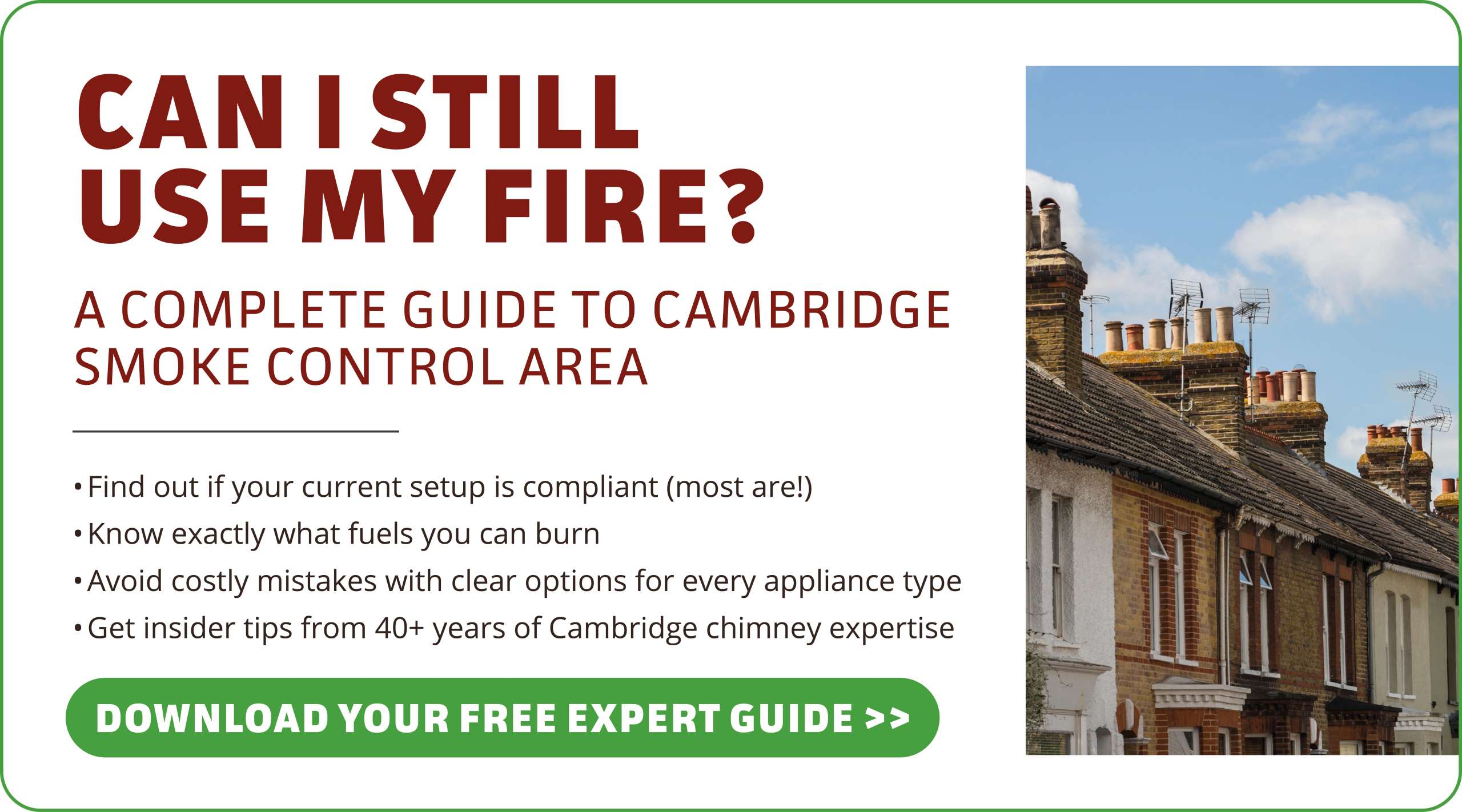If you have an open fireplace in Cambridge, you’re probably wondering what the new city-wide Smoke Control Area means for your cosy winter fires. The good news is straightforward: you can absolutely continue using your open fireplace – but there are clear rules about what you can and can’t burn.
As chimney professionals who’ve been helping Cambridge residents navigate Smoke Control Area requirements since the original areas were established in the 1960s, we know that open fireplace compliance is actually the most straightforward of all the heating options. Here’s everything you need to know.
The Simple Rule for Open Fireplaces
From January 2026, if you have an open fireplace in Cambridge, you can only burn approved smokeless fuels. This rule is clear, consistent, and has been successfully operating in parts of Cambridge for decades.
What this means:
- No wood burning (except small amounts of dry kindling to start fires)
- No house coal
- No household waste or inappropriate materials
- Only fuels specifically approved for use in Smoke Control Areas
The reason for this restriction is simple: open fireplaces don’t have the controlled combustion systems that modern stoves use to burn wood cleanly. Without these systems, wood burning in open fires produces significantly more smoke and particulate emissions.
What You CAN Burn
Approved Smokeless Fuels
All of these are permitted in open fireplaces within Smoke Control Areas:
| Anthracite Coal | Naturally smokeless, burns very hot and longExcellent heat output, minimal ash productionMore expensive but very efficientBurns with a blue flame, virtually no visible smoke |
| Semi-Anthracite Coal | Similar properties to anthracite but slightly lower gradeGood heat output with minimal smokeMore affordable than full anthraciteBurns cleanly with little visible emission |
| Low Volatile Steam Coals | Specially processed to reduce smoke emissionsGood for sustained, steady heatApproved varieties clearly marked on packagingBurns efficiently with minimal residue |
| Manufactured Solid Fuels (MSFs) | Processed fuel products made from various materialsMust display “Authorised for use in smoke control areas” on packagingAvailable in various shapes: ovals, beans, nuggetsOften designed to mimic coal appearance and burning characteristics |
How to Identify Approved Fuels
Check the packaging: Look for clear text stating “Authorised for use in smoke control areas” or “Approved for smoke control areas”
Verify online: Check the official DEFRA database
Ask your supplier: Reputable fuel merchants should be able to confirm approval status
Look for recognisable brands: Many established fuel manufacturers clearly mark their approved products
What You CAN’T Burn
Prohibited Materials
| Any Wood (except kindling) | Seasoned, unseasoned, kiln-dried – all prohibited in open firesThis includes logs, wood pellets, and wood briquettesException: small amounts of dry kindling to start fires |
| House Coal | Traditional bituminous coal produces excessive smokeNot approved for Smoke Control AreasMuch higher emissions than smokeless alternatives |
| Household Waste | Paper, cardboard, packaging materialsCreates toxic emissions and excessive smokeIllegal and dangerous to burn |
| Treated Wood | Painted, varnished, or preserved timberFence panels, furniture, construction materialsReleases toxic chemicals when burned |
| Other Inappropriate Materials | Rubber, plastics, textilesGarden waste when wet or unsuitableAny material not specifically designed as approved fuel |
Why These Restrictions Matter
Open fireplaces lack the controlled air supply and secondary combustion systems found in modern stoves. When inappropriate materials are burned:
- Incomplete combustion creates excessive smoke and particulates
- Toxic emissions can be produced from treated materials
- Higher pollution levels affect local air quality
- Increased risk of chimney fires from tar buildup
The Kindling Exception
You ARE permitted to use small amounts of dry wood kindling to start your fire, even in a Smoke Control Area. This practical exception recognises that getting smokeless fuels to ignite can be challenging without proper preparation.
Guidelines for kindling use:
- Use only dry, seasoned wood
- Keep quantities small – just enough to establish initial combustion
- Transition to approved smokeless fuel once flames are established
- Avoid creating excessive smoke during the lighting process
Best practice for lighting:
- Place a layer of approved smokeless fuel in the fireplace base
- Build a small kindling structure on top
- Light the kindling and allow flames to establish
- The burning kindling will ignite the smokeless fuel below
- Add more approved fuel gradually as needed
Making the Switch: What to Expect
If you currently burn wood or house coal in your open fireplace, switching to approved smokeless fuels involves some adjustments:
Burning Characteristics of Smokeless Fuels
| Heat Output: | Modern smokeless fuels often provide more consistent, longer-lasting heat than traditional coal or wood |
| Appearance: | Many manufactured fuels are designed to look similar to coal and provide attractive flames |
| Lighting: | May require different techniques – smokeless fuels can be slower to ignite than wood |
| Ash Production: | Generally less ash than wood, making cleanup easier |
| Odour: | Much less smoke means reduced odours both indoors and for neighbours |
Cost Considerations for Smokeless Fuels
| Per unit cost: | Smokeless fuels are typically more expensive per bag than house coal or logs |
| Efficiency: | Higher energy content often means you need less fuel overall |
| Heat duration: | Longer burning times can offset higher initial costs |
| Convenience: | Less frequent refueling needed compared to wood |
Tips for Better Burning with Smokeless Fuels
Lighting Technique
| Proper preparation: | Ensure your fireplace is clean and ash levels aren’t excessive |
| Good airflow: | Open dampers fully and check that air vents aren’t blocked |
| Quality firelighters: | Use proper firelighters rather than accelerants |
| Patience: | Allow time for smokeless fuels to properly ignite before adding more |
Fuel Management
| Don’t overload: | Add fuel gradually rather than filling the fireplace completely |
| Size matters: | Use appropriately sized fuel for your fireplace opening |
| Storage: | Keep smokeless fuels dry to maintain their efficiency |
| Quality suppliers: | Source from reputable dealers who guarantee fuel standards |
Maintenance for Clean Burning
| Regular sweeping: | Annual minimum, more frequently for heavy users |
| Clear airways: | Ensure chimney draw isn’t restricted by blockages |
| Damper operation: | Learn to control airflow for optimal burning |
| Ash removal: | Clear ash regularly but leave a thin base layer for insulation |
Frequently Asked Questions
Will smokeless fuel give the same atmosphere as wood?
Modern smokeless fuels are designed to provide attractive flames and good heat output. While the experience is different from wood, many users find the reduced smoke and longer burn times preferable.
Can I burn smokeless fuel and wood together?
No. In a Smoke Control Area, you cannot burn wood in an open fireplace except for small amounts of kindling to start fires.
What if I have leftover logs from last winter?
You’ll need to find alternative uses for wood logs – perhaps giving them to someone with a DEFRA-approved stove, using for outdoor fires, or storing until you can install a compliant stove.
How do I know if smokeless fuel is working properly?
Properly burning smokeless fuel should produce minimal visible smoke once established, provide good heat output, and burn steadily without excessive sparking or spitting.
Planning Your Transition
Before January 2026
| Test different fuels: | Try various approved smokeless options to find what works best in your fireplace |
| Source reliable suppliers: | Establish relationships with fuel merchants who stock approved products |
| Schedule maintenance: | Have your chimney swept and inspected to ensure optimal performance |
| Learn new techniques: | Practice lighting and managing smokeless fuels before you need to rely on them |
Storage and Supply
| Dry storage: | Keep smokeless fuels in a dry location to maintain efficiency |
| Adequate supply: | Plan ahead for winter months when demand is higher |
| Delivery options: | Many suppliers offer delivery services for bulk purchases |
| Emergency backup: | Keep extra supplies for unexpected cold periods |
Local Suppliers and Resources
Finding Approved Fuels
| Local coal merchants: | Many Cambridge area suppliers stock approved smokeless fuels |
| Garden centres: | Often carry manufactured solid fuels suitable for open fires |
| DIY stores: | Major retailers typically stock approved products |
| Online suppliers: | Delivery options available for bulk purchases |
Verification Resources
| DEFRA database: | The official source for checking fuel approval status |
| Manufacturer websites: | Most producers clearly identify their approved products |
| Supplier confirmation: | Ask your fuel merchant to confirm compliance |
| Packaging labels: | Always check for approval statements on bags |
Benefits of Making the Switch
For Your Home
| Cleaner burning: | Less smoke means less residue on walls and furnishings |
| Better efficiency: | Smokeless fuels often provide more consistent heat output |
| Reduced maintenance: | Less tar and creosote buildup in your chimney |
| Insurance compliance: | Meeting local regulations supports insurance requirements |
For Cambridge
| Improved air quality: | Reduced particulate emissions benefit everyone’s health |
| Consistent standards: | City-wide rules create fair, clear expectations |
| Environmental benefits: | Lower emissions contribute to cleaner air for all residents |
| Health outcomes: | Particularly beneficial for children, elderly, and those with respiratory conditions |
Expert Chimney Services for Clean, Compliant Burning
Getting the most from your chimney while meeting UK emission standards requires professional expertise. As authors of the City & Guilds Chimney Sweeping Qualification and certified Guild of Master Chimney Sweeps, Ablewight Chimney Services combines industry-leading knowledge with practical experience.
Our comprehensive chimney services ensure optimal performance, legal compliance, and safety:
- Professional chimney sweeping – Annual cleaning and maintenance
- CCTV chimney surveys – Advanced inspection technology
- Stove servicing – Complete maintenance and performance optimisation
- Bird nest removal – Wildlife-compliant clearance
- Bee nest removal – Safe clearance
- Tar and creosote removal – Specialist cleaning for heavy deposits
- Compliance certification – Insurance-valid documentation
- Expert advice – Personalised solutions for your heating system
Why Choose Ablewight:
- HETAS Approved for professional standards
- Trading Standards Approved for consumer protection
- Guild of Master Chimney Sweeps certified
- £5 million public liability insurance
- No-mess guarantee on all work
Get Professional Chimney Care Today:
- 01223 627012
- hello@ablewight.co.uk
Service Areas: Cambridge • Ely • Newmarket • Royston • Saffron Walden • St Ives • Huntingdon • St Neots • Bishop’s Stortford • All surrounding villages within 25 miles
Don’t compromise on safety, performance, or compliance. Contact Ablewight Chimney Services today for professional expertise you can trust.



